Judith Works's Blog, page 7
June 30, 2015
ICE CREAM FOR BREAKFAST - Syracuse
Surely it is a breakfast suitable for the Greek gods who formerly inhabited this lovely part of Sicily: gelato in a fresh and soft brioche accompanied by ice coffee – cold, creamy, sweet and strong enough to keep me awake for at least 18 hours.

We sat outside a café on the waterfront near the Fountain of Arethusa along with the locals who were analyzing the latest political and soccer news. I was analyzing a guide to the part of Syracuse known as Ortigia. The Greeks founded their city here in 733 B.C. and it gradually grew to rival Athens before the Romans took over in 211 B.C.
The freshwater spring, which flows into a pond full of ducks and feathery papyrus, is named for a young woman named Arethusa. When a Greek river god fell in love and pursued her she plunged into the sea to escape. She reappeared in Ortigia where the goddess Artemis transformed her into the lovely spring – not a bad fate I thought.

Needing to walk off our breakfast, we strolled toward the bridge linking the island to the main city to contemplate the ruins of the Temple of Apollo, built not long after the city’s founding, The architect’s name, Kleomenes, is still visible chiseled into the ancient stone. Could he ever have dreamed that he would be still remembered 3000 years later?

Daily life goes on no matter how many ruins surround the inhabitants, and there is no better way to see it than in the mouthwatering market. Oh the tomatoes, the tomatoes!

Of course we were hungry afterward. I ordered a salad with the tomatoes mixed with oranges. green and black olives, red onions and topped with a sprig of basil. Divine.
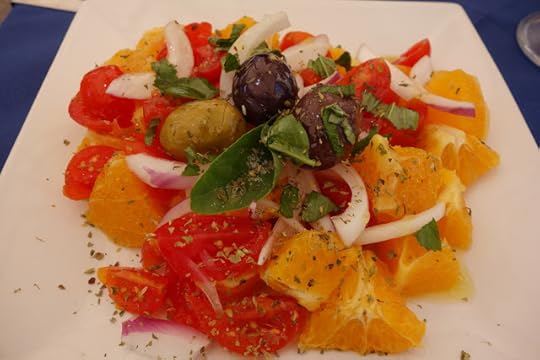
Then a stroll along the seaside to the Castle Maniace built in 1212 by Frederick II to protect the harbor.
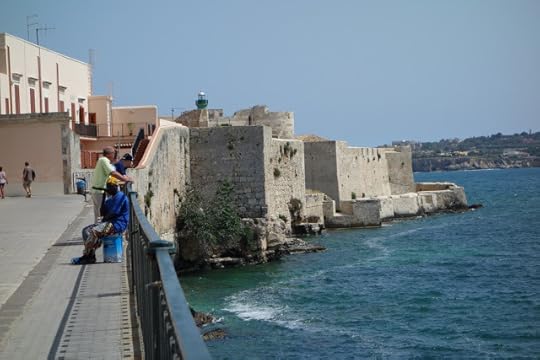
Fortunately we had two more days to explore the area so we finally subsided at a sidewalk café across from our hotel, the Antico Roma, to watch the evening passeggiata with lovers embracing, tourists with guidebooks, exuberant children, and elderly couples walking arm in arm to enjoy the warm evening. And a future Formula One driver!
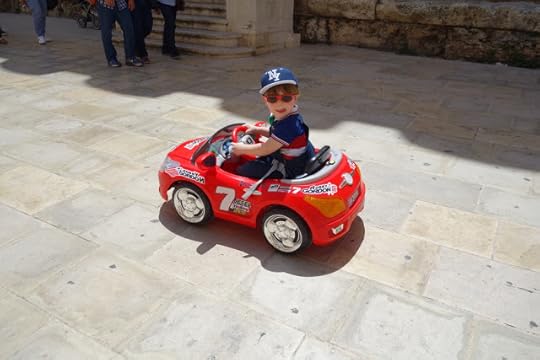
The marvelous Duomo was our first goal the following day. The Baroque façade faces the Piazza Duomo which is ringed with golden- colored Baroque buildings including the Town Hall and the Archbishop’s Palace.
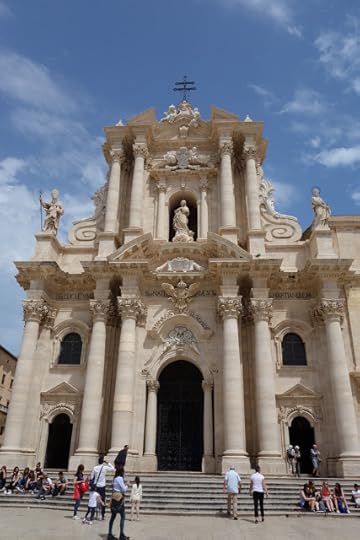
At the far end of the piazza is the church of Santa Lucia alla Badia now housing a Caravaggio painting titled The Burial of St. Lucy. Unfortunately the painting is very dark and set so far back from the viewer that it was difficult to see.

The Duomo’s foundation was begun in 480 B.C. when a tyrant of Syracuse, Gelon, was victorious in a war with another Greek city. In celebration he decided to build a temple to Athena which was filled with ivory, gold, white Parian marble from the island of Paros and considered the best in the ancient world. The Doric temple was famous throughout the Mediterranean world and sailors were guided by the sun reflecting on Athena’s shield above the entrance. The riches were looted by the Romans and have long-since disappeared but 24 of the original 36 columns are still standing.

First converted to a church by the Byzantines, changed to a mosque during the Arab times, the Normans made alterations and the Spanish added a ceiling of chestnut wood. It was rebuilt in its current form after 1693 when it began to crumble due to earthquakes.
We lingered in two chapels in the Duomo. One is dedicated to St Lucy who was martyred in 304 and supposedly had her eyes gouged out. The very odd Baroque marble plaque shows her eyes on a stand with a sword symbolizing the manner of her death. No surprise to find out she is the patron saint of the blind, those with eye infections, and aptly, us long-suffering writers. (And I thought the sword looked like a pen.)

The Cappella del Crocifisso with a splendid painting of the founder of the church, St. Zosimus, attributed to Antonello da Messina.

Below is a reliquary with many of the saint’s bones. I always wonder how the bones so frequently displayed in churches were obtained, and if they really belong to the person venerated.
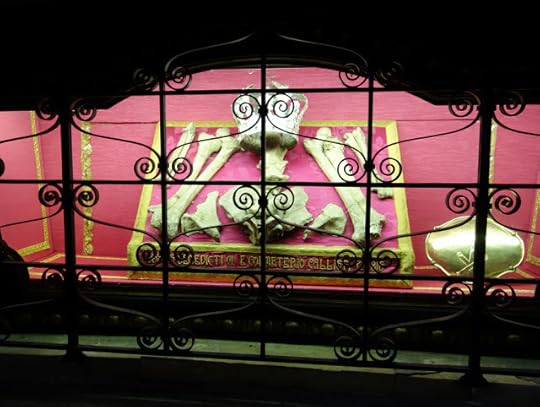
In the evening it was time for a change from the sacred to the profane – a traditional puppet show with knights, Moors, and our heroine, Angelica. The theater had a small museum and a workshop where disembodied heads and other body parts hung from the ceiling.
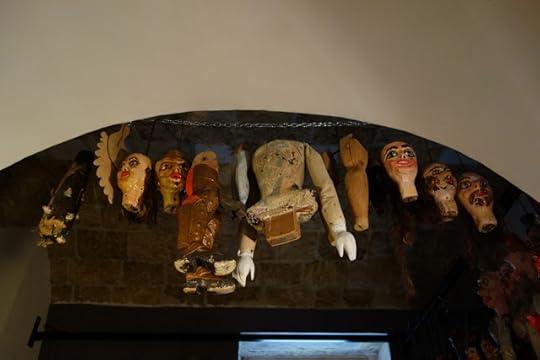
Rather disconcerting until we saw the amusing puppet of a horse pulling a traditional Sicilian cart – the horse has both right legs off the ground, quite a balancing trick.
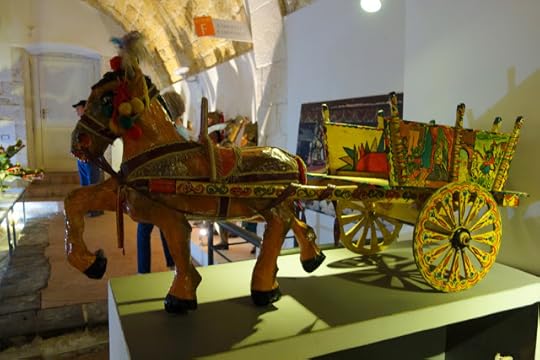
When the performance was over and all ended happily it was time for an evening prosecco and a discussion of which bar we should try for our morning coffee and gelato. More chocolate or something more daring like pistachio?
All photos except The Burial of St. Lucy and the gelato copyright Judith Works. Photo of Burial of St Lucy is from Wikipedia Commons. Photo of gelato is courtesy Margaret Jessop.
Published on June 30, 2015 16:01
June 3, 2015
ROMAN ROSES

One of the pleasures of a sunny Roman day in May is taking a leisurely stroll through the Communal Rose Garden which is open during that month when the blooms from over 1100 plants are exuberantly flourishing.

The ancient Romans were rose fanciers and supposedly the current site was originally home to a temple dedicated to Flora, the goddess of flowers.

Wealthy banquet hosts showered their guests with petals as a finale to the meal. (And in the spirit of excess attributed to several emperors both Nero and Heliogabalus (204-222) were reputed to have suffocated guests by dumping piles of petals from a false ceiling. Anyone who has seen the kitschy overwrought painting by Alma-Tadema done in 1888 won’t forget the story.) Fortunately that sort of thing is out of fashion and the flowers are available for all to enjoy without fear.

The garden overlooks the Circus Maximus and the Palatine Hill. I suspect few other such gardens have a more spectacular setting. The layout is divided into two, the lower half is set aside for the annual competition called the Premio Roma; the upper is a compendium of ancient varieties such as Gallica, Alba, and Damascena, and modern plants with intriguing names like Princess Margaret, Dark Lady, Diana, and Pinocchio. Hybrids, miniature, rambling - all are there for you to breath in their intoxicating scent.


The center walkway and curving pathways recall the shape of a menorah. I thought this a curious choice until I learned the history of the area after the temple to Flora vanished in the dust of time: Originally, Roman Jews were assigned a space for their graves on the opposite side of the Tiber, but when Pope Urban VIII built new fortifications to protect Trastevere the Jews were “allowed” to buy land on the northern slope of the Aventino in 1645. The area was called Ortaccio degli Ebrei and an old photo shows a lovely and peaceful site.

My 1904 Baedeker makes a brief mention recommends the site as a place to get a pretty view of the Palatine (the Circus Maximus was only a faint outline at that time).

By 1930 the deceased had been relocated to the main Roman cemetery, Verano, and the site was designed in its current form. Other than the layout and a couple of plaques a visitor would never know the history although the tall and dark cypresses on one site still evoke the traditional Italian cemetery.

Photos copyright by author except for fresco and painting in public domain and old cemetery from www.romeartlover.it.
Published on June 03, 2015 09:51
April 27, 2015
PAPUA NEW GUINEA
The ship glided over the still tropical waters of Astolabe Bay toward Madang.

The romantic name of the bay comes from its “discoverer,” Dumont d’Urville who named it after his ship when he sailed in in 1827. We were accompanied to the dock by locals in small boats singing and waving to us – tourist dollars approaching often brings joy to this part of Papua New Guinea.
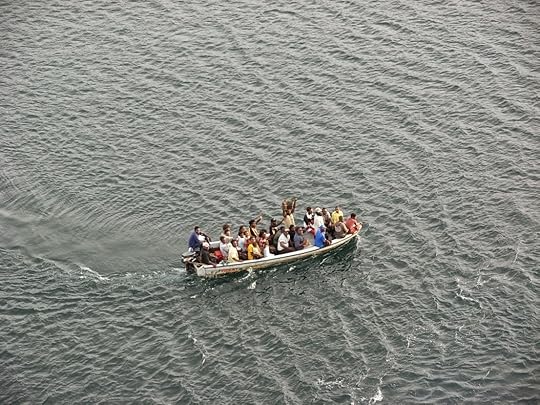
The town, deep in the jungle-rimmed bay, seemed to me a hot and humid collection of random buildings, and trees filled with large bats having a nap, although it boasts several resorts for intrepid travelers and NGO workers in need of R&R.
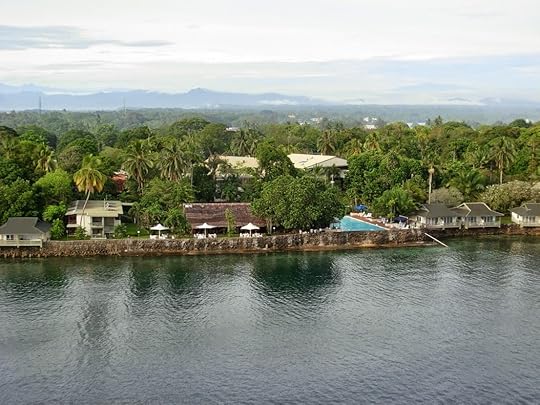
Near the dock a copra-processing plant was in operation. As we stopped to take a look, one of the workers ambled over to tell us the processed coconut meat would be shipped to Australia for cattle feed. We walked on to the tiny museum. I managed to snap a photo of a sea-going outrigger but was shooed away when I wanted to photograph more artifacts.

I could not help thinking of the recent book about Michael Rockefeller, Savage Harvest, recounting his end on the other side of the island where he was naively collecting carved poles as primitive art, not understanding that they were memorials of cannibal feasts. And I also thought of Lily Tuck’s recent novel, Euphoria, set far to the west of Madang where Margaret Mead and others studied native tribes who told them imaginative tales which may have been factual – or not.

With nothing much to see in town, we decided on a tour to an outlying village.

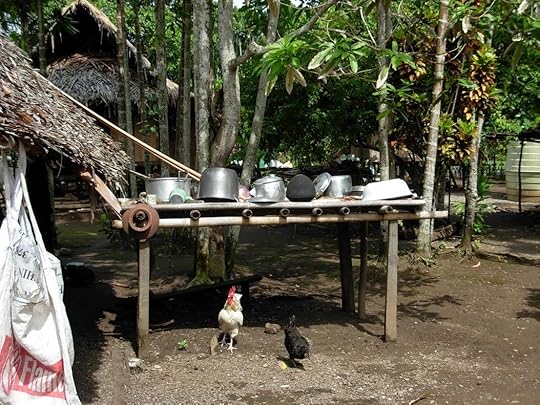
While it was interesting to see how people lived we were struck by the enormous number of children – a population explosion it seemed.


The village hosted a Lutheran school and clinic, a legacy of German domination from 1884 – 1914. It was Sunday and most of the children were at Sunday school and they appeared happy and well cared for. But we could not help wondering about their future in such an impoverished country.

Our visit was for tourists so the locals brought out tattered feathers, grass skirts and bare bosoms for entertainment. It was embarrassing for us to be gawking at their desultory display. And the children were embarrassed too. Sunday school over, they flocked to see the show, giggling and pointing at their parents. Somehow the whole event seemed off, nothing more than a sad remnant of a fast-vanishing culture. Not a National Geographic moment.

By the time we returned to the dock, the local people had set up a market showcasing their real skills: wood carving. A shopping frenzy began, buyers and sellers smiling as they bartered. I briefly contemplated buying a penis gourd for my son-in-law but decided not to, although he told me later he would have “treasured” the souvenir. We settled for a dolphin and a pig of a size we could carry, along with a bunch of orange and yellow lobster-claw helicona and bird of paradise to grace our cabin, but other passengers bought piles of large carvings that would have to be fumigated before loading.
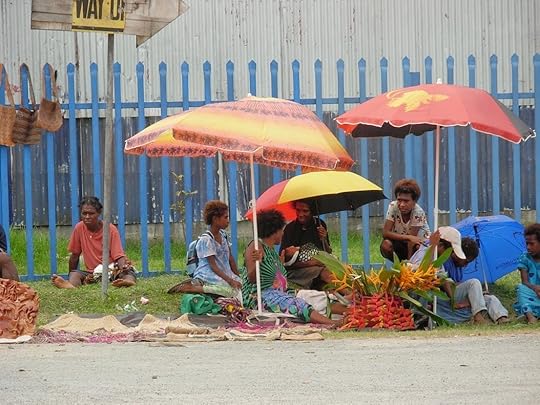
We walked back to the ship past the dismal sign warning against AIDS, rampant in the country. A sad reminder that trouble still stalks this beautiful, sometimes menacing, and mysterious land.

All photos copyright author, Judith Works
Published on April 27, 2015 09:40
March 29, 2015
NOVA SCOTIA AND NEW BRUNSWICK - Lobsters and Lighthouses
I’ve wanted to return to Nova Scotia for years. The last time was so long ago about all I remembered of Halifax was the sign on the wrought iron gate at the entrance to the public park: “Beware the Cross Swan,” and marvelous lobster meals. After touring the city we had ventured down the rocky coast to Peggy’s Cove, the tiny town whose beauty was captured by the misty watercolors done by W. E. deGarthe. The lobster boats and traps and the lighthouse marking the entrance to the narrow harbor are a painters’ and photographers’ dream and a place I wanted to visit again.
This time around my husband had the time to tour the north island and the Bras d’Or Lake which takes up much of the interior. The lake, ideal for sailing in summer, was dull as the last of the fall leaves were falling and clouds were heavy. Fortunately, hospitality was still available in the form of restaurants offering the seafood bounty of the area.


We stopped at the small town of Baddeck to visit the Alexander Graham Bell museum. What a surprise! I didn’t know he and his wife, who was profoundly deaf, had summer home nearby, or that the man who brought us the telephone was a prolific inventor of countless other devices: the respirator, audiometer, electric heaters, and the flat record. He was a pioneer in aviation, inventing ailerons and the three-wheeled undercarriage. He was also co-founder of the National Geographic Society with his son-in-law. Along with all his other activities he befriended Helen Keller. The museum is little known but worthy of a journey. His home and burial site are nearby but not open to the public unfortunately.

The lower part of the province provided more delights: a return to visit Peggy’s Cove.




and then continued on to the UNESCO World Heritage site, Luneburg, the home of the replica Bluenose II racing yacht and colorful buildings. And a lobster lunch!

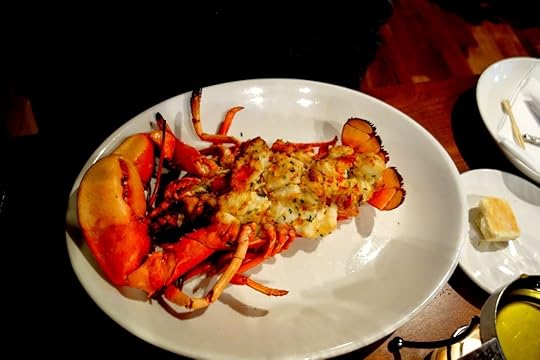
The biggest attraction in New Brunswick is the tides in the Bay of Fundy, where the tide changes an astounding 50 feet between high and low water twice every day. We watched the outflow, amazed at the power and speed of the water. Seeking something more to human scale after, we idled in the Victorian-era market in the center of St. John. The fall produce was tempting, everything fresh and inexpensive. We tasted dulse, a dried seaweed snack and dietary supplement, interesting but an acquired taste, and bought jars of wild blueberry jam instead.


A cup of rich lobster chowder in a seaside restaurant in the tiny coastal settlement of St. Martin was our lunch. We walked off the meal on the beach, a benign scene in contrast to rushing tide earlier in the morning. The inter-tidal zone was littered with smooth rocks, many in a heart shape, whether from the action of wind and wave or from Cupid I don't know. But my husband picked one up for me as a small token of love. Now a sweet souvenir by my bedside.

Later, we returned to the city to watch the reverse surge of water filling the St. John River – the power of the water a reminder of how Nature rules our lives whether with heart shapes, fresh fall bounty or from the uncontrollable power of water.
Published on March 29, 2015 14:42
February 25, 2015
DOING THE CHARLESTON
Charleston, South Carolina is a delight. And Southern hospitality is everywhere.

We recently spent two days there – not nearly enough to sample all the offerings but enough to know we would like to return. Foodies, gardeners, history buffs, architecture vultures and culture mavens can all find plenty of attractions in lovely old city under the southern sun.

The food was a new experience – in the Pacific Northwest we don’t see a menu with gumbo, she-crab soup and red rice and deviled crab cakes, and we enjoyed every mouthful.

The city was founded in 1670 by English settlers but by 1708, the majority of the population were slaves. Their culture, often called Gullah, can be felt in the food with its emphasis on rice, and the music that was originated by dockworkers – and yes, it was called the Charleston. The Gershwins set Porgy and Bess in the city, and the beautiful sweet grass baskets are widely for sale. We paused to look at some of the intricate work outside the 1841 Market Hall filled with food and trinkets to tempt tourists.


The harbor is guarded by Fort Sumter set on an island. Now a historic site the memories of the Civil War loom large over parts of the town like the battery where the cannons that fired the first shot on April 12, 1861 remain. Signposts throughout the city remind strollers about the dramatic events that took place in the city. And the military is still a prominent influence with shaven-headed Citadel students marching on the school’s grounds and several military bases on the outskirts of the city.

But the city isn’t all about war. The old part of the city is filled with historic homes, gardens, pastel homes and wrought iron that have survived the Revolutionary War, earthquakes and hurricanes.

The sound of horses hooves clomping through the otherwise quiet streets make it easy to believe you have been transported back to ante-bellum times even though the carriages are hauling tourists.

Several of the historic homes are open for tours. We especially enjoyed the Nathaniel Russell House, a Federal style townhouse built in 1808.

The furniture is original . The music room with its many windows, peach walls, lyre-backed chairs, harp, and blue couch is a place to dream of a past now long gone. But of course that past had another side, slavery kept the household running. Lest we all forget, there is a marvelous photo near the foot of the free-flying elliptical staircase. A household slave complete with white headscarf sits solemnly on a chair facing the camera. On her lap is a young white child dressed in lacy finery. I could no help thinking about their lives – what became of them and others who lived in the lovely old homes during and after the Civil War?

Could they have dreamed that the city would survive and thrive into the cultural mecca it is today? And could they have pictured jazz-age flappers dancing the Charleston in smoky speakeasys or jet planes being manufactured on a gigantic Boeing assembly line?

Photo of Josephine Baker courtesy of Wikipedia Commons. All other photos copyright Judith Works
Published on February 25, 2015 10:23
January 25, 2015
IN THE HEART OF ETRUSCAN COUNTRY
One of my favorite day trips from Rome is heading north into the dreamy scenery of Etruscan country, that area of northern Lazio and bits of Tuscany and Umbria where the Etruscans once roamed.

Our first stop one summer day was Vitorchiano a tiny town, set on a cliff between two ravines. It was originally a Roman fort and the inhabitants haven’t forgotten their history – they still regard themselves as Roman. We paused at a local market set up near a fountain to browse the irresistible selection of fruit.

But our pleasure was tempered by an angel casting its shadow on the names of the dead from World War I, a typical melancholy reminder of Italy’s troubled past found in every town.

After passing through the ancient city walls we poked around in churches and shops, enjoying a gelato before heading down the steep and winding road toward Vetralla, our destination.

An odd sight confronted us by the side of the road as we zipped by: a statue in the style of those from Easter Island. If anyone can explain this mystery please let me know.
My friend in Vetralla, Mary Jane Cryan, is a long-time resident of the small city, and writer of the popular blog, Fifty Years in Italy (50yearsinitaly.blogspot.com). Vetralla has a curious history. Part of the Etruscan triangle of Tarquinia and Tuscania, some inhabitants still have Etruscan DNA, but it is also the only place in the world outside the UK that was under the “protection” of the English crown as proclaimed by Henry VIII in 1512, followed by a long association with the exiled Stuart monarchy in the 1770s. It is interesting to contemplate what would happen if Italy and the UK went to war. Would Margaret Thatcher have sent in the troops?

Ms. Cryan lives in an enormous apartment in one of the Renaissance palazzi fronting the ancient Roman road, the Via Cassia that runs down the middle of town. Vetralla is also set high on a cliff like Vitorchiano and most other towns in the area, and as typical, the back sides of most of the buildings loom over the rich farmland below. Her splendid apartment is filled with books and memorabilia, but it is the terrace, with its sweeping views, that makes the home a place of enchantment.



While we sat in the sun the talk naturally turned to food. (Is there any conversation in Italy that doesn’t include food?) Mary Jane mentioned that a friend, Fulvio Ferri, had recently published a cookbook filled with family recipes. Unable to resist an addition to my Italian collection we came home with Olio e Ricordi in Cucina – loosely translated as Grandmother’s Recipes, along with a copy of Mary Jane’s latest book, Etruria, Travel, History and Itineraries in Central Italy. If you are interested in either book you can go to www.elegantetruria.com.
Although we don’t have olive oil from Vetralla in Seattle we tried out some of the recipes. We particularly liked the one for roast potatoes, Patate al Forno con Rosmarino o Finocchio, often found on Italian menus but not so often in cookbooks:
Here’s our take on the recipe which serves 4 - 6:
10 medium-size thin-skinned boiling potatoesSprigs of fresh rosemary (we didn't use fennel)2-3 cloves of garlicSalt & pepper to tasteExtra virgin olive oil
Pre-heat oven to 360 F or 180 C.Peel potatoes and put in cold water so they don’t darken.Place the mixture of oil, salt, pepper, finely-chopped rosemary and garlic in a bowl large enough to toss the potatoes.Dry potatoes, cut into wedges one inch thick, coat with the mixture, and arrange in a single layer on non-stick baking pan.Bake until just tender (varies from 30 minutes to an hour).Crisp the potatoes for a few minutes by turning on the oven fan.
Serve hot. And plan another trip to Italy!
Copyrite Judith Works. All photos by author except for view of Vetralla by Mary Jane Cryan
Published on January 25, 2015 07:31
December 28, 2014
MILAN - CAPITAL OF STYLE
I’m one of those people who love Milan. It doesn’t have ancient ruins or hordes of tourists but it is the Italian capital of design, especially fashion. The last time we arrived at the central train station evidence of the creative zest was everywhere from the 1930-era mosaics near the tracks to the fashion stores filling the main concourse and upper levels.


A few subway stops away is the historic center dominated by the Gothic spires of the Duomo, or main cathedral. Begun in 1386, it was finally finished in 1809 on orders of Napoleon.

We climbed up to the roof to take in the view of the distant Alps and marvel at the intricacies of design and construction of the building.

But when lunch time arrived our eyes moved from the statues topping the spires (and the sight of a woman helplessly watching her cell phone slide off the steep roof into the abyss) to what the people on the seventh-floor terrace of La Rinascente department store opposite were eating. Sacrificing ancient stones in favor of a caprese under a sun umbrella, we joined the other diners after passing by the chocolate shoes crafted in honor of upcoming Fashion Week.

All the women looked like models or buyers for boutiques and all the men looked like stylists. Their talk was as animated as the swirls of smoke from elegantly held cigarettes wafting in the breeze.
We walked off lunch by strolling in the Galleria Vittorio Emanuele, a monument to the Milanese lifestyle built in 1877, They were filled with tempting fall outfits to wear when strolling along avenues lined with chestnut trees whose leaves were beginning to flaunt their own fall colors. The glass-domed mall with its intricate inlaid floors serves as Milan’s living room where sipping an espresso or Prosecco and watching the fashionistas gazing at the shop windows isn’t a bad way to while away an afternoon.
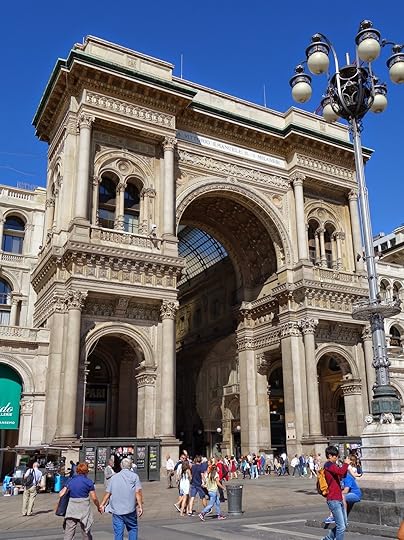

But we wanted our afternoon coffee in the sun.We ventured onward to La Scala,the premier opera house in the world. The season would not begin until late fall but we enjoyed a coffee at the bar outside the entrance to the museum which celebrates the great Italian composers Verdi and Puccini and some of the divas (one from the 1800s with the delightful name of Giuditta Pasta even though Milan’s favorite starch is risotto). Actually, I love the name as it is Italian for Judith and what could be better than paired with my favorite food.
Next to us was a trio of well-tailored Milanese businessmen who seemed to have all the time in the world to drink their afternoon cappuccinos (normally considered a no-no in Italy) and gesture expressively in animated talk. While we watched them out of the corner of our eyes we reminisced about our night at the opera several years ago. The production of Rigoletto was superb – equal to the amount of the bribe we paid to get the tickets.
This time around we skipped the faded da Vinci fresco, The Last Supper, in favor of a tour of the The Museum of 1900s (Museo Del Novecento), and the Villa Necchi-Campiglio. Both buildings are in the Italian Modernist style of the 1930s - my favorite architectural style.
The museum, a few steps from the Duomo, leads the visitor on a survey of Italian art from 1900 to the 1970s. The top floor contains a neon installation by Lucio Fontana that sets off a view to the Gothic Duomo, neatly putting a parenthesis around much of Milan’s history.


The Villa is set in the fashion district, a short distance away.

Built, built between 1932 and 1935, with its gardens, tennis court and swimming pool gives a taste of the rich life of a prominent industrialist. My favorite room is the Veranda with huge windows that slide open in the summer, inlaid marble floor, pale green S-shaped sofa, and a lapis-lazuli table set with blue Chinese vases. It was easy to visualize the former occupants reading or chatting with friends like the Kings of Italy and Spain who dropped by to visit.

But did I mention shopping?Did I mention shoes, chocolate or otherwise? Lest there be any doubt about Milan’s focus, our hotel room had maps and booklets stuffed with information about the hundreds of designers whose boutiques and showrooms line the area around Via Spiga and Via Montenapoleone, along with many other shopping districts.

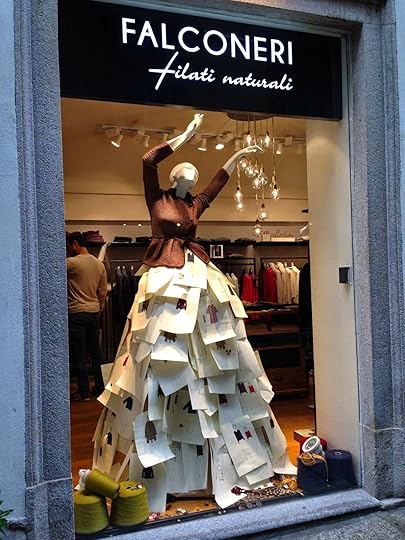
The section on expenses in my 1904 Baedeker’s Guide to Italy advises, “When ladies are of the party the expenses are generally greater.” One hundred ten years later nothing has changed.
Published on December 28, 2014 15:10
November 29, 2014
THE COLORS OF ROME

Rome is a city of pastel colors, mellowed by the ages.

The original brilliant white marble of the ancient Roman ruins is mostly weathered now.

Except for the monument to Vittorio Emmanuele II that shocks the eye with its dead white mass. So out of character with the rest of the city. It's often know as the wedding cake or typewriter.

Ancient wood has weathered to gray and the original brick is exposed.

The bronze doors of the Roman Curia (Senate) in the Forum have turned to verdigris green as have statues and the original doors now at the Basilica San Giovanni.

The old Roman brick retains warmth from millennia of sun.

The stucco facades of burnt sienna and terra rossa radiate warmth.


My favorite color is red. The Roman designer, Valentino, has his own flaming red signature color. The luscious color signifies the allure of fashion and temptation. And of course, we can't forget Ferrari Red. Pompeiian Red – that rich color so beloved by the ancient Romans to express the richness of life. It was made of cinnabar which contained mercury; now it is made from iron oxide. Infrequently seen on buildings, the ancient Romans loved it on frescoes.

The sky is a brilliant blue and the umbrella pines are a deep and dark green.

Vegetables are always bright and tasty.

Some of the small colors flaunt their colors too.

Medieval floors of marble and glass glitter in the shifting light.

And above all, the vivid Italian flag of red, white and green flutters.

All photos by the author except for the fresco painting which is from the website Ancient Rome and the photo of the sidewalk cafe, courtesy Krista Bjorn.
Published on November 29, 2014 11:50
November 9, 2014
BLOWNBACK: Trying to see Quebec in a Nor'easter

Trying to see Quebec in a Nor’easter isn't easy, it turns out. My first try out the door resulted in being blown back inside. The wind sent people rushing either backwards or forwards or even off their feet, and the few remaining brightly-colored leaves whirling off the trees. It was freezing with the wind chill.
I had not been in the beautiful city of Quebec for many years and was looking forward to enjoying fall color while strolling in the sun through the upper town and the Plains of Abraham where in 1759 Generals Wolfe (British) and Montcalm (French) led their troops in the battle to control Canada.The British won but both generals died of mortal wounds. I wanted to stroll on the terrace in front of the Chateau Frontenac and visit the museum in the Ursuline monastery and show my husband General Montcalm’s skull (why I don’t know but the last time I saw it the relic was displayed by a 95-year old French nun who had the most beatific face I have ever seen.) It was not to be because the wind in the upper town was too strong to make headway. Instead we retreated to the lower town close to the river where we saw warnings about the coming winter and the dangers of ice falling off the buildings.

We wandered the cold streets to enjoy the street art while contemplating whether I should buy one of the fur coats in the show windows of the many furriers.
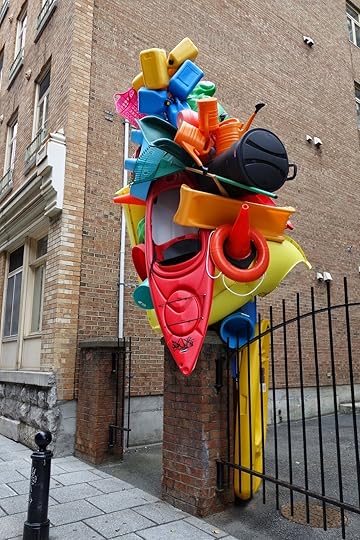

Discarding the idea, we warmed up in the lovely small church of Our Lady of the Victories, named after the French who resisted two British sieges, one in 1690 and the other in 1711. The ship model hanging in the nave is the Breze, a 17thcentury vessel that brought French troops to Quebec.
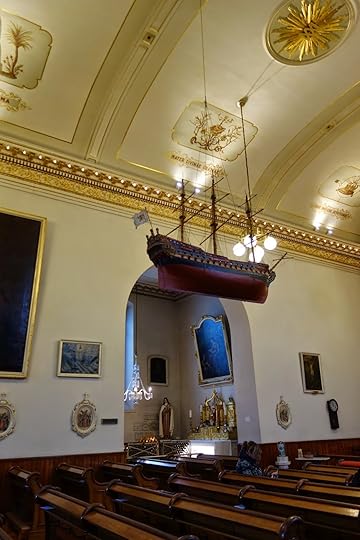
But when we passed a closed restaurant with a terrace decorated with dead branches and feathers from birds who long ago had departed for warmer climes, we gave up. Further touring of the UNESCO World Heritage Site would have to wait for another season.

A taxi driver ferried us up to the looming hotel Chateau Frontenac, a great pile of stone built by the Canadian Pacific Railroad, completed in 1893. One of its many claims to fame is the meeting with Winston Churchill and Franklin Roosevelt 1943 to plan the Allied Invasion on D-day.

It’s now managed by the Fairmont, and is luxurious indeed. We whiled away the afternoon with lunch in the terrace restaurant, Bistro Le Sam, and at the bar called 1608, the two names memorializing the founding of the city by Samuel de Champlain in 1608. The focus on the selection of local cheese and charcuterie is highlighted on their website: http://www.fairmont.com/frontenac-que....
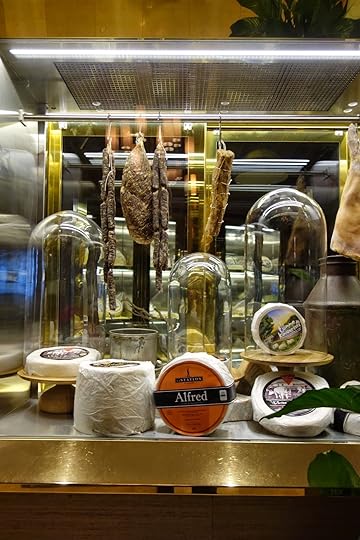


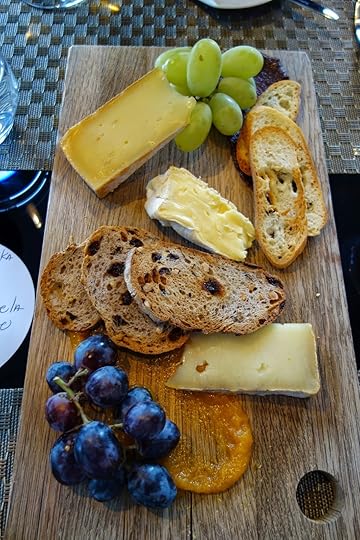
Our lunch focused on a cheese plate from Quebec artisan cheesemakers: from top to bottom in the photo the cheeses are Kamouraska, Gaulois, and Reserve del la Perade. Delicious! As was the Chardonnay and the view over the river.
Unwilling to leave, we moved to the bar for another glass of wine before heading out into the cold.

The gorgeous décor features a globe with three Canada Geese winging their way. One appeared to be flying in a southerly direction. When we put our empty glasses down we followed its lead.


Published on November 09, 2014 13:07
September 29, 2014
MACHINES AND GODS IN ROME

One of the twenty museums managed by the city of Rome, is the Centrale Montemartini. It’s also one of the most creative. I don’t know who thought up using the city’s first public electricity plant, built in 1912, to display works from the “basement” of the Capitoline Museum, but whoever it was a stroke of genius.
While other old buildings along the Via Ostiense were torn down, this one was saved because of its architectural significance. Built in Art Nouveau style, the white building was named after an Italian economist of the period. The area along the busy thoroughfare that was once the direct route to Ostia and the sea is rather scruffy but improving. The museum is set back behind office buildings in a courtyard where the lovely lamp standards and the little water hydrant with the ever-present SPQR (the Senate and the People of Rome) welcome the visitor.

Beyond the exhibit of the industrial past, a tribute to industrial archeology, the museum opens out into two floors of treasures from the time when Rome ruled the world. And what treasures they are:mosaics:

grave monuments,


gods and gilded youth,

the remainders of a colossal statue of the goddess of fortune,

and a row of Roman portrait sculpture from the Republican era.

The most striking displays are those placed in juxtaposition with gigantic black boilers, massive turbines and diesel engines.

I have to admit, my favorite of all the sculptures, is one of a not-so-humble shoemaker (just like Rome, Italian shoes are eternal). This fleshy guy, who must have been proud of his appearance, had the tools of his trade sculpted above his portrait. If he was worried about his place in history, he can find comfort from all the visitors who contemplate his memorial (although I suspect a few might snicker).

Each era has its wonders, and the museum is a good place to contemplate how one led to another.
For more information you can go to www.centralemontemartini.org
All photos, copyright by Judith Works.
Published on September 29, 2014 12:42



